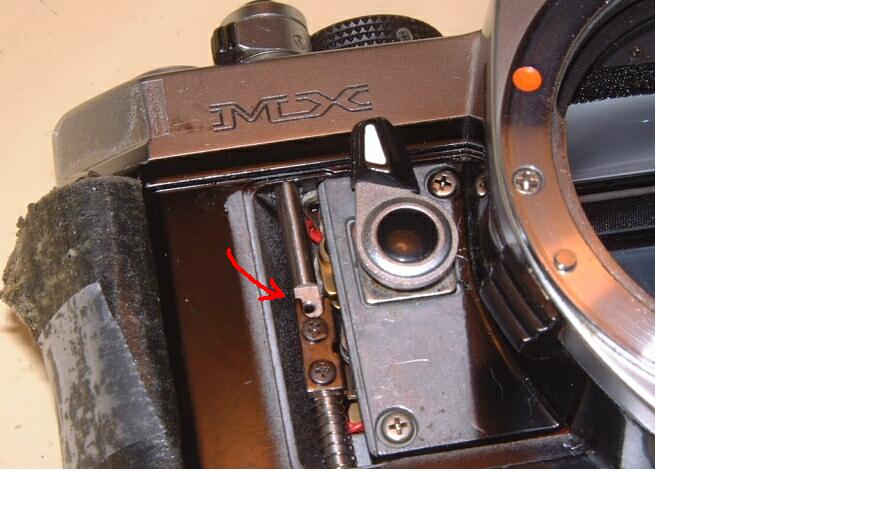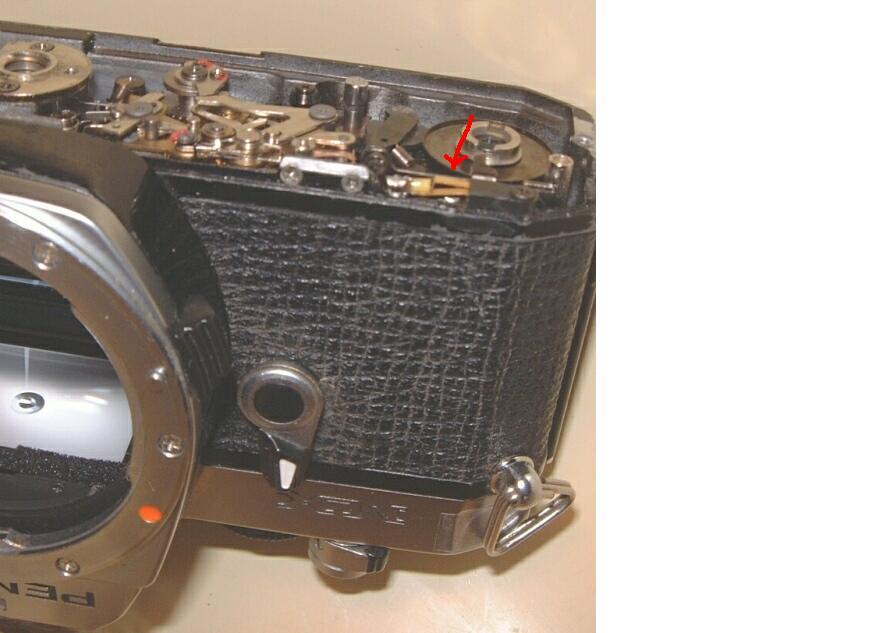
Does the Pentax MX have mirror lock-up? and some technical stuff
Mirror lock-up has a major beneficial effect on reducing vibrations around shutter speeds of 1/8 to 1/30 second. Herbert Keppler conducted a test of this that was reported in Popular Photography in June of 1999, and found sharpness gains (lines per mm of resolution) increased by about 40% when the mirror was locked up.
I have done a similar test with my Pentax MX, and the difference in fine detail is quite noticeable when magnified to the equivalent of an 8x10 photo. To see a side by side comparison of the effects with and without MLU, click here. (In the 4x6 print from which this is scanned, the photo album in this shot is 1.5 inches tall. These photos were taken at 1/15th second with a Pentax 50mm f/1.7 A lens. I should note that I used quite a light tripod, and the difference might be less noticeable with a more solid one -- however, a light one is the kind I like to carry around.)
The MX has the added benefit that its shutter is a horizontal cloth one, which adds very little vibration of its own.
The Pentax MX (and other fully mechanical Pentaxes) have the ability to lock-up the mirror though there is no actual control for it. (I have read of one instance where an MX was modified with an external switch to do it.) The reason it can happen is that they have a multi-step linkage that flips up the mirror (and releases the lens diaphragm, which can also contribute to vibration) at separate stages. However, it is not by any means a foolproof feature, and may not work on all MXs.
It takes a bit of practice to learn how to do it, but it's a lot easier than learning to ride a bicycle. Once you have the knack of the "MX flick," it is easy to do, and you will almost never go "past" and accidentally trip the shutter before you want to.
On most MX's, you can't do this by pushing on the shutter release. It has to be a very quick flick -- presumably because it's the nature of the shutter release that its release depends not just on pressure but on the duration of the pressure.
The first step to get yourself into position is to press the tip of your index finger against the bottom of your thumb. Aim your hand so that when you release your index finger, the nail on that finger will hit the shutter release button. A little bit of practice should get you there.
Once the mirror is locked up, you can release the shutter using the self-timer or a cable release.
This procedure was written up in the March 1979 issue of Modern Photography, when a reader named Thomas Scales wrote a letter about it. He mentioned in his letter that "this was demonstrated to me by a Pentax representative and is a factory recognized procedure." The editors responded that they consulted a Pentax technician who told them that "it does work -- at some times on some cameras. It all depends on the internal linkage, which can vary from camera to camera." This is also my experience. I have tried it on about 8 MX's, and it worked on 6 of them.
Occasionally, after you have locked up the mirror, it will not come back down even after you have released the shutter. In that case, all you have to do is wind the shutter and the mirror will come back down. I have also come across one MX where the shutter opened half way when the mirror went up, overexposing that side of the frame. So experiment before you take any important shots with your MX.
I have opened up an MX, and through trial and error discovered what determines the possibility of mirror lock-up on the MX. It appears to depend on the fact that the actuating arm (Part OA50402, for those of you who have the service manual that Mark Roberts kindly put on his web page) that goes from the shutter release button to the firing gears has a degree of adjustability with regard to the angle at which it hits.
There are two tiny Philips screws that attach the actuating arm to the rod that comes down from the shutter release button. The screws thread into the rod, but the holes in the actuating arm are larger than the thread diameter, and so when you loosen the screws you can make small changes in the angle of this arm. I found that when you push the top of the actuating assembly as far as it goes to the right (when facing the camera; this can be seen in the photo below.) you have full-fledged mirror lock-up on the MX. In this condition, if you ease down gently on the shutter release button, it will lock up the mirror. That is to say, you don't have to flick it as described above. You can keep a cable release in the shutter release button, and still cause the mirror to lock up, which can be a convenience factor if you take a lot of pictures this way. When you use the self-timer, the mirror goes up and the diaphragm closes down a second or two before the shutter fires. The only downside, as far as I have been able to determine, is that you have to tap the shutter button a bit more sharply than on a regular camera when you want the mirror to release in the normal way.

Incidentally, it is quite easy to get to this part of the camera. Just peel up the corners of the leatherette with a small flat head screw driver, and ease it backwards. You do not have to remove the self-timer lever. When that lever is turned so that it points directly to your left, the leatherette can be lifted off over it (if you do it slowly and carefully) without tearing it.
The whole shutter mechanism is obviously a knife-edge proposition in the MX. Tiny changes in this adjustment will result in various odd combinations of behaviour, the most alarming of which is the shutter going off without the mirror lifting. Any playing around is at your own risk. You are dealing with tiny, delicate parts, and a slip of the screwdriver can cause irrepairable damage. However, if you have a few old MX's and can afford to ruin one, it can be fun to experiment.
While we are on the subject of opening up MX's, here is another tip, for repairing what seems to be a common electrical fault. In some MX's, the meter does not shut off, draining the batteries. Sometimes you are aware of this because the LED's stay on. However, there is a more insidious form in which the contact is too slight to turn on the LEDs, but it drains the batteries after a couple of days anyway. This occurs because the same shutter rod just discussed is not pulling the meter switch components apart far enough. (The tiny brass arms in the photo below.) This is very easy to fix. Just take out the three screws that hold the bottom plate. With a very fine pair of tweezers, bend up very gently on the top brass arm of this switch. When the shutter button is in its up position, there should be a tiny gap between these two parts. When you squeeze down part way on the shutter button, it should allow the springiness of the upper arm to come into contact with the lower arm, completing the circuit.
That's another nice thing about the MX compared to modern electronic cameras: it has the potential to be repaired by a mechanically adept amateur.

Return to my Photography Page.